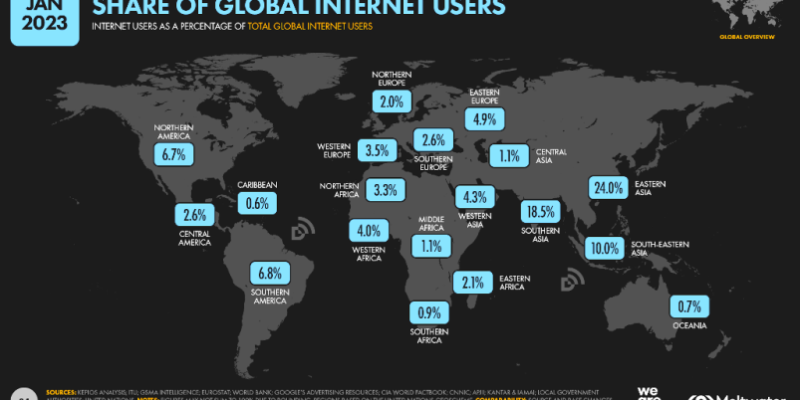Population of global offline continues steady decline to 2.6 billion people in 2023. Accelerating progress is key in race toward universal and meaningful connectivity.
- About one-third of the global population, or 2.6 billion people, remain offline.
- More people are connected than ever before but progress needs to accelerate.
- Sustained efforts are needed to achieve universal and meaningful connectivity by 2030.
The number of people worldwide not connected to the Internet decreased to an estimated 2.6 billion people in 2023, according to the latest data from ITU, the UN tech agency.
RELATED: Internet users to reach six billion in next five years
The reduction from the estimated 2.7 billion people offline in 2022 leaves 33 per cent of the global population unconnected in 2023.
Sixty-seven per cent of the world’s population, or 5.4 billion people, are now online.
“This improvement in connectivity is another step in the right direction, and one more step towards leaving no one behind in support of the UN Sustainable Development Goals,” said ITU Secretary-General Doreen Bogdan-Martin. “We won’t rest until we live in a world where meaningful connectivity is a lived reality for everyone, everywhere.”
Acceleration needed to bring digital benefits to all
According to early estimates, growth in Internet connectivity remains the strongest in low-income countries where data indicate that Internet users increased by about 17 per cent over the past year. However, less than one-third of individuals are connected to the Internet in these countries.
“We must not forget that behind this data are people who are not able to access the Internet and enjoy the life-changing benefits that it can bring in the era of digital transformation,” said Cosmas Luckyson Zavazava, Director of ITU’s Telecommunication Development Bureau. “These numbers highlight the importance of measuring and tracking data so that we know where to focus our efforts to meaningfully connect everyone to the Internet by 2030. With these developments, we must also focus on building digital skills for all to equip users with the necessary skills that may help unlock value and have a rewarding safe experience online.”
The latest global estimates confirm that the double-digit growth in Internet connectivity observed at the 2020 peak of the COVID-19 pandemic was short-lived.
Current trends are not strong enough to guarantee that the objective of universal and meaningful connectivity will be met by 2030.
Ensuring that everyone benefits from digital technologies
Achieving universal and meaningful connectivity by 2030 – the possibility for everyone to enjoy a safe, satisfying, enriching and productive online experience at an affordable cost – requires a comprehensive approach that addresses infrastructure as well as other factors such as affordability and skills.
The Internet is an essential tool to access information, employment opportunities and education. People without meaningful access may be left behind. This becomes more important as technologies such as artificial intelligence become more prevalent in our day-to-day lives.
ITU works closely with partners to ensure that those who are connected have the skills and knowledge to use it.
ITU projects aimed at making connectivity meaningful include the ITU Academy, the ITU Academy Training Centres (ATC) Network and “Promoting and measuring universal and meaningful digital connectivity,” a project funded by the European Union. ITU’s Partner2Connect Digital Initiative serves as a pledging platform and action framework to advance universal connectivity and digital transformation globally.
The new estimates on global connectivity come as ITU and UNDP prepare to convene SDG Digital at UN Headquarters in New York on 17 September to take stock of how digital technologies can support the Sustainable Development Goals and explore the opportunities offered by digital technologies to accelerate them.
Detailed global, regional, and country-level analysis for key connectivity indicators tracked by ITU will be released later this year in ITU’s annual flagship Facts and Figures report.































